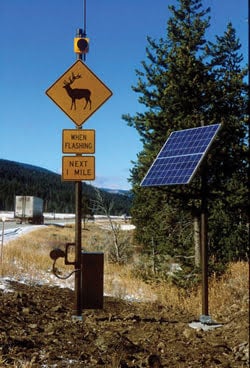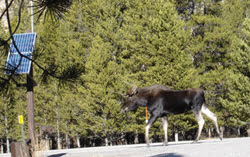Anne L. Fischer, Senior Editor
As vehicular traffic increases, so do animal-vehicle collisions. Detection systems that sense when an animal may be near the road are installed in a few US states and at several locations in Europe to warn motorists to exercise caution.
The Western Transportation Institute at Montana State University in Bozeman conducted a six-year study of animal detection systems installed in approximately 30 locations in several countries. The systems are designed to reduce the number of automobile accidents by using 15 technologies, including passive and active infrared, laser, microwave and seismic sensors that activate warning signs telling drivers to slow down.
The researchers calculated the average total cost associated with animal-vehicle collisions to determine if the detection systems could reduce it. The cost of a typical animal detection system per mile per year is about $31,000. A single collision with a moose, for example, costs an average of $28,100. In addition, national statistics show that about 200 people are killed, more than 15,000 injured and 300,000 vehicles damaged annually because of collisions with wildlife and domestic animals. The study concluded that the financial benefits of the systems are greater than the cost in areas where there is an average of five deer, three elk or two moose collisions per mile of road length in a year.
Most of the installed systems fall into two categories of operation. Area-cover systems use passive video, passive infrared or active microwave radio sensors that detect movement and/or body heat within a certain area of coverage. Break-the-beam systems use transmitters and receivers with infrared, laser or microwave radio signals. When an animal blocks the signal, the system is activated. There also are seismic sensor systems that are used in combination with above-ground infrared sensors and systems that trigger the warning signals when radio-collared animals come within range of receivers.

Figure 1. This animal-detection system was installed on US Highway 191 in Yellowstone National Park in Montana. Powered by solar energy, the system alerts drivers when elk are on or near the highway. Photo by Marcel P. Huijser, Western Transportation Institute, Montana State University.
One break-the-beam system was installed in Yellowstone National Park in Montana in 2002. A 1-mile-long section of US Highway 191 uses a continuous microwave radio-frequency signal of 35.5 GHz. Developed by Sensor Technologies and Systems Inc. of Scottsdale, Ariz., the system was designed to detect animals at least 30 inches tall. If the signal is blocked, a UHF radio signal is sent to the master station, which sends the beacon-on command to the three nearest beacons. These flash above an elk warning sign, alerting oncoming traffic that a large animal may be in the road.
The system was set up to record every break of the beam, duration, date, time and section number. The designers thought they could remotely access the data from a cell phone modem; however, cell phone coverage in the area was insufficient. Terry Wilson, engineering department manager of Sensor Technologies, said that they now access data by satellite connection. Additionally, they installed solar panels, which were designed to operate without down time due to darkness and snow cover. Shady spots and snow did cause a power problem at one post, but an additional battery seemed to alleviate it, according to Wilson.
Technical maintenance has been on-going with the Montana setup as well as physical maintenance to reduce false-positives that occurred when shrubs and grass triggered the system. Researchers also found that the warning signs were activated by passing vehicles and snowdrifts, or even by spray from snowplows. Software filters were added to the system, which reduced the number of false-positives.
Overall, the system has been successful in detecting elk and has proved to be reliable. However, the researchers noted a number of problems. There are substantial blind spots at locations with curves and slopes because of design errors. One of the sensors was damaged when a car ran off the road and hit it, and an elk warning sign and a solar panel have been stolen. In addition, residents are concerned about the appearance of the equipment, complaining that it degrades the quality of the landscape and that the reflection of the sun off the solar panels is a nuisance.
The problems with the animal detection systems have been primarily environmental or maintenance issues -- not due to any lack of capability of the technology, according to Bill Goodson, president of Goodson and Associates of Lenexa, Kan. His company uses active infrared with a separate transmitter and receiver placed on opposite sides of the trail. It can set the height of the beam, so that it can be triggered by large animals, such as deer and elk. And with software, it could determine how long the beam must be interrupted before an event is triggered.
Cutting the red tape
Although the technology and systems are available, only five of the sites studied are operational in North America and 15 in Europe. Willy Berchtold, representative for Calonder Energie AG, a Swiss company that has many successful installations in Europe, agrees that the technology is there and that the success has been great, but sees governmental red tape as the greatest obstacle. Governments in Europe and in the US (both state and federal) get involved with cost, location and ultimate approval of the systems, which can greatly impede progress.
Goodson surmises that product liability problems are another issue in the US, and he would like to see more government/industry collaboration whereby government supports such products that can have a far-reaching social impact -- in this case, safety.
One example of government/industry collaboration is the proposed fence along the 2000-mile US/Mexican border. Goodson sees it as much the same as a trail or highway detection system, but he thinks that vandalism will be a significantly larger problem because those who traffic illegal immigrants will undoubtedly find ways to decommission sections of the fence long enough to get people through. He points to the highway speed detection systems in Europe, which are easily inactivated when vandals spray-paint the cameras.

Figure 2. A moose moves close to the animal-detection sensor (lower left), about to trigger a warning signal to motorists and ensure its safe crossing. Photo by Lloyd Salsman, Sensor Technologies and Systems Inc.
Detecting deer or elk near a highway, however, is a far simpler task than monitoring a 2000-mile border. Although approval and installation may be slow, the technology is there to facilitate the prevention of animal-vehicle collisions. Data from the Montana report shows that collisions with large wild animals can be reduced by 82 percent on average with the use of animal-detection systems.
The Montana state researchers are continuing their study, with a focus on system reliability and driver reaction to the warning signals. At Sensor Technologies and Systems, engineers are working toward reducing energy requirements of the systems to cut long-term costs.